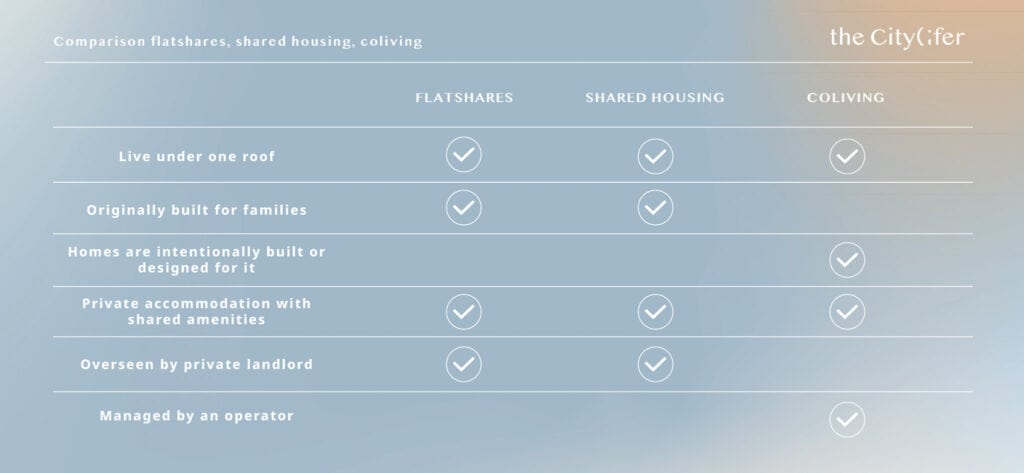Years ago, adulthood meant living in your own home with a white fence, in a peaceful suburban pocket. But as times change, our perception of everyday living also changes. Today, a modern lifestyle is all about comfort in a convenient urban address. And now where possibilities are endless, new ways of living are always exciting. In comes flat sharing, or living with one or more people in a rented apartment or house. It provides affordability and the opportunity to live with like-minded people. Which is why it is a common option for students, graduates, and professionals. In this article, we let you in on the basics of flat sharing to paint a clear picture of this dynamic way of modern living!
Take a Look into the World of Flat Sharing
Providing accessibility and easy living, flatshares are popular in globalized locations worldwide. Between 2020 to 2022, coliving in Europe has received an investment worth €1.2 billion. Private rentals in the UK have also become popular in the country. Notably, people in multiple occupation homes increased from 429,000 in 2012 to 497,000 in 2018. And more than two fifths of these properties are in England’s capital city, London. While it is common for young people, flat sharing has no age limit. In the UK, the number of people aged 55 to 64 years old seeking shared housing went up by 239% from 2011 to 2019. Those aged 45 to 54 years old rose by 114%.
Benefits of Flat Sharing
As an affordable option, flat sharing offers a solution for individuals grappling with the escalating cost of living. As of 2023, global prices have, on average, risen by 7.4%. With costs continuously increasing, navigating it alone may pose challenges. Single-person households allocate 92% of their income for basic necessities, while those in two-person households spend relatively less, allocating 83% of their income.
Additionally, flat sharing enhances one’s social life by letting like-minded people build networks. Social connections are good for your health, especially in reducing stress and anxiety. Flat sharing also minimizes the burden of handling the general upkeep of an entire home all on your own.

Types of Shared Housing Arrangements
Shared housing is where two or more people live under one roof with communal spaces. It’s strongly related to flatshares and shared buildings.
Flatshares are usually family homes whose bedrooms are divided among the residents. These are classified according to demographic or arrangement:
Student flatshares
Working professionals flatshares
Live in landlord flatshares: a person that owns and lives in a property and rents out one or more rooms
Live out landlord flatshares; a landlord that rents out all the rooms in the property to tenants
Shared buildings are properties comprising many dwellings with common and private apartments. These let residents enjoy the privacy of their own rooms or apartments. Common areas generally include the kitchen, bathroom, and living room. Some properties might also provide good quality co-working and leisure spaces for tenants.
Coliving spaces offer the above-mentioned features, as well as a sense of community. They are built to foster a community of people with similar interests. A coliving property is managed by operators, while flatshares are overseen by landlords.s

Considerations Before Flat Sharing
Like with other major life decisions, you also have to consider a lot of things before you live in a flatshare. Take into account the kind of space you want and need, as well as your preferred address. Decide if you want to live in a quiet suburb or a new city, then look online for property listings in those areas. Do take note that flatshares are mostly found in big cities! You also need to keep your budget in mind. Specifically, see if it matches your desired room size and amenities. Apart from these, also check your compatibility with others. Have you lived with many family members, friends or roommates? How do you cope with having other people in your living environment? Your answers to these questions may show you how you’ll experience living in a flatshare.
Navigating Potential Challenges
As convenient as it is, flat sharing also comes with its own set of challenges. Common issues include late payments, untidy areas, excessive noise, and personal conflict. But with communication and respect, managing these setbacks is possible. Establishing the following agreements will serve as your guidance in maintaining the place:
Create a system for cleaning duties. Take notes of all needed chores and assign them among yourselves. Even if you’re not responsible for a specific area in the flatshare, keep everything tidy at all times.
Lessen noise disturbance. A way to keep things orderly is reducing noise in the shared flat, especially in quiet hours. Keep tabs of your flatmates’ schedules to avoid disturbing them in their times of rest.
Take care of both personal and shared items. Respecting your roommates is the bare minimum but the little things do count. For example, be careful not to hog the flat’s shared spaces and items. Also, don’t forget to seek permission from your roommate before borrowing their belongings.
Set proper reminders for payment schedules. Set calendar reminders for regular bills and rental expenses to avoid extra charges.

Tips for Finding the Right Flatmate(s)
For starters, outline your preferences in cleanliness, smoking habits, pets or hobbies. These will help you assess your prospective roommates from the get-go. Then, look in your local networks, FlatMate, SharedStay, property websites, and Facebook groups. Afterwards, conduct interviews, which could be online or in person. Also, be honest about yourself so all expectations with each other are realistic.
Creating a Harmonious Living Space
Communication is the key to having a harmonious living space. This helps in setting expectations, addressing issues beforehand, and minimizing misunderstandings, and conflict. Respecting each others’ privacy and boundaries are crucial everyday aspects of flat sharing. This can be knocking before entering or informing your roommate beforehand about visitors. Agree on how you divide chores, and be mindful of shared items like utensils and tools. Make sure to pay bills to avoid interruption of electricity and water services. Community activities like potlucks and clean-ups also enable peaceful living with others.

Legal and Financial Aspects
The legal and financial sides of flat sharing may be too overwhelming but they keep things in order. Consult with a legal professional to form a document that serves as a guide and protection for all. It should have the home’s address, monthly rent and utility costs, and how they are divided. The agreement also has the terms of stay and termination, and jurisdiction. In managing shared financial responsibilities, they should be split fairly and fulfilled regularly. It must be clear among all your residents in the unit which payments are shared and will only be paid by one person. Setting phone reminders and automatic bank transfers help prompt payments for regular bills. A joint bank account is good for emergency repairs, and expense tracking.
Conclusion
Flat sharing is common among young professionals, digital nomads, local and international students. Offering shared expenses and responsibilities, it provides convenience in a big city centre. But, it is important to also consider the challenges of living with other people. These include incompatibility as well as conflict in payment terms and house rules. To live harmoniously with your flatmates, have open communication and follow set agreements!
The Citylifer Perspective
Here at The Citylifer, we’re all about balancing a sense of privacy and community. In our people-centric spaces, we aim for positive relationships and individual experiences. The Citylifer redefines coliving by providing the following:
Community clusters
The Citylifer has a goal to establish a sense of community within our properties. Our “community clusters” comprise up to 25 residents, making building connections easy.
Trailblazers
Our community clusters also include the Trailblazers. These are long-term residents who guide newcomers, ensuring inclusivity and acceptance. They help solve conflicts between residents, and report to The Citylifer as needed.
Established house rules
The Citylifer has house rules for residents’ comfort and security in our properties. These cover respecting privacy, keeping shared areas clean, and mindfulness of noise levels.
Cleaning of shared areas included
We understand that cleanliness is paramount in all places, especially in communal areas. So here at The Citylifer, we also have regular cleaning in shared areas. This way, we make our properties more enjoyable and stress-free to stay in.
Privacy and social connectedness
We provide residents with privacy and social connectedness here at The Citylifer. They can enjoy the privacy of their own apartments. Also, they unwind and interact with their fellow Citylifers in our family or co working rooms.
Flexible arrangements
Adapting to flexible work arrangements, The Citylifer adjusts leases based on your needs. You have the option to avail one month leases, and extend it as needed.
FAQ
No, flat sharing has no age limit.
No. Flat sharing is about living with one or more people in a home. It’s not about the familiarity (or lack thereof) you have with your flatmates. Although, it is common to live with people you’ll know for the first time, which is also quite an experience on its own!
Everybody has their own preferred way of living; and if flat sharing is the one that suits you best, go for it! We’re at a time where housing prices keep rising, so there’s no shame in being in shared housing.





